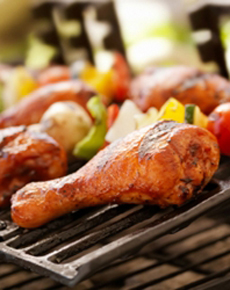Summer food safety tips from AUT experts

Summer is upon us and with it comes outdoor eating and plenty of barbecues.
But with warmer weather often comes less than ideal food preparation environments.
Being food safe over summer
Suzanne Bliss, the AUT University food safety coordinator, says keeping food hygienic and safe to eat is not difficult, as long as people are aware of the risks and know how to keep food safe over summer.
“Whether at home, the beach or at a holiday camp there are risks associated with cooking and preparing food,” says Bliss.
She says maintaining adequate refrigeration, thorough cooking and reheating, personal hygiene and clean work surfaces and equipment are all important if the holiday season is to be memorable for the right reasons.
“Some of these food preparation incidents also occur by leaving food at a critical temperature for too long. You need to minimise the time food is at room temperature and keep high risk foods chilled.”
Kiwis love to barbecue
Some of the most popular items to cook on the barbecue include sausages, mince patties and chicken and all of these items need to be cooked thoroughly she says, and erring on the side of caution it is best to avoid any evidence of bloody juices.
Professor of food microbiology at AUT Dr John Brooks says that to ensure chicken is cooked throughout; pre-cooking in the microwave is the best approach.
“Check the internal temperature of chicken reaches 74 degree Celsius. Patties must also be cooked through, so it pays to use a meat thermometer. The United States Department of Agriculture suggests 71.1 C for beef burgers because the original outside meat has been mixed through, whereas a steak can be cooked rare, provided that the outside is seared.”
Another favourite is seafood, and Bliss says only ever collect seafood like shellfish from safe areas and to avoid red tides, sewerage outfall areas as well as areas deemed unsafe by local councils.
The outbreak of a killer strain of E.coli in Europe earlier this year serves as a timely reminder for New Zealanders to be extra cautious about the spread of food poisoning as well.
“The outbreak of E. coli O104:H4 was one of the worst on record and certainly one of the most deadly, spreading to over 16 countries and killing more than 50 people. Our modern food supply chains are extremely complex as foods are sourced from all over the world.”
TOP TIPS
- Be careful with personal hygiene- wash and dry hands frequently when preparing food
- Make sure raw food, especially chicken, is separated from other foods and stored in sealed containers and keep chilled; take chilly bins and ice packs to keep things cold
- Make sure you cook high risk food thoroughly and serve and eat promptly
- When eating outdoors, keep your food covered to prevent contamination from insects, birds and pets